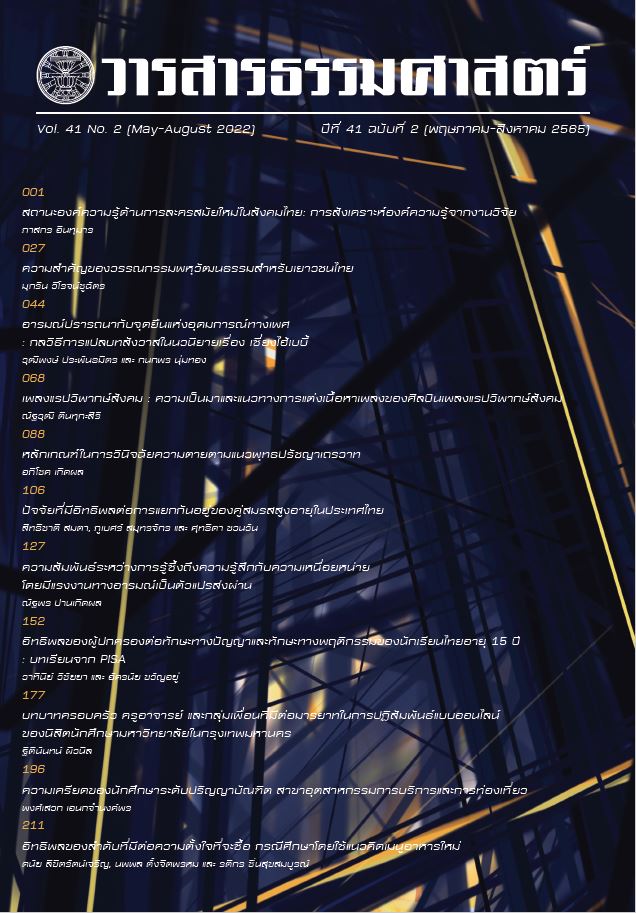Sexual Desire and Gender Ideology: Translation Strategies of Erotic Motives in “Shanghai Baby”
Main Article Content
Abstract
In literature, erotic motives represented sexual desire and aesthetics of human sexual arousal and revealed a writer’s gender ideology. Correspondingly, translators’ gender identities and ideology were also accordant with these components, for they
arranged justice for their identities through their translation techniques when the novel was translated into foreign languages. The research objective was to study translators’ gender ideology and connotation of their translation strategies for erotic motives in
Chinese literature named Shanghai Baby by Wei Hui. The text would be compared with an English-translated version by Bruce Humes, a directly translated version from Chinese, and a Thai translation by Kam Phaka, translated from English. The study found that the translators purposely connote their viewpoint through various translation strategies, such as omission, substitution, partial translation, adjustment, addition, and euphemism. Consequently, the study depicted that the translators’ genders were the relevant factors for communicating the erotic motives to readers. Also, this feature functioned as a space to form identity and subdue each other between males and females through language aesthetics, which passionately and intensely portrayed the characters’ desire for their sexual intercourse movement.
Article Details
References
กนกพร นุ่มทอง. (2554). ต้าราการแปลภาษาไทยเป็นภาษาจีน. กรุงเทพฯ: สถาบันขงจื๊อ มหาวิทยาลัยเกษตรศาสตร์.
กษมา สัตยาหุรักษ์. (2544). จันดารา สังวาสนาฏกรรมบนจอเงิน. กรุงเทพฯ: ระหว่างบรรทัด.
เฉลิมศรี จันทสิงห์. (2529). การแปลเบื้องต้น: ทฤษฎีและแบบฝึกหัด (พิมพ์ครั้งที่ 2). นครปฐม: โรงพิมพ์มหาวิทยาลัยศิลปากร วิทยาเขตพระราชวังสนามจันทร์.
ดวงตา สุพล. (2541). ทฤษฎีและกลวิธีการแปล (พิมพ์ครั้งที่ 4). กรุงเทพฯ: โรงพิมพ์แห่งจุฬาลงกรณ์มหาวิทยาลัย.
นัทธนัย ประสานนาม. (2555). วันนี้ท้องฟ้าแจ่มใส: ชิกลิทเชื้อสายตะวันออกของหลิวจงเวย. วารสารจีนศึกษา, 5(5), 186-198.
บุญรส วงจัตุรัสธรรม. (2537). วิจิตรกามาในอารยธรรมจีน. กรุงเทพฯ: คุ้มคำสำนักพิมพ์.
บุรินทร์ ศรีสมถวิล. (2563). การก้าว “ไม่” ข้ามความเป็นอื่นด้านภาษาในคำบรรยายใต้ภาพ ภาษาจีนเรื่อง “เกียร์สีขาวกับกาวน์สีฝุ่น” วารสารจีนศึกษา, 13(2), 509-547.
พันศักดิ์ อัศววงศ์เกษม. (2561). เรื่องเพศกับการเซ็นเซอร์: การแปลภาษาต้องห้ามในนวนิยาย เรื่อง Fifty Shades of Grey ของ E. L. James. วารสารการแปลและการล่าม, 3(2), 90-137.
วรรณา แสงอร่ามเรือง. (2563). ทฤษฎีและหลักการแปล (พิมพ์ครั้งที่ 3). กรุงเทพฯ: สำนักพิมพ์ จุฬาลงกรณ์มหาวิทยาลัย.
วารุณี ภูริสินสิทธิ์. (2545). สตรีนิยม: ขบวนการและแนวคิดทางสังคมแห่งศตวรรษที่ 20. กรุงเทพฯ: คบไฟ. เว่ยฮุ่ย. (2546). เซี่ยงไฮ้เบบี้(คำ ผกา แปล). กรุงเทพฯ: แพรวสำนักพิมพ์.
สัญฉวี สายบัว. (2543). หลักการแปล: กิจกรรมสู่ความเข้าใจ. กรุงเทพฯ: สำนักพิมพ์ มหาวิทยาลัยธรรมศาสตร์. สุพรรณี ปิ่นมณี. (2555). แปลผิด→ แปลถูก: คัมภีร์การแปลยุคใหม่. กรุงเทพฯ: สำนักพิมพ์ จุฬาลงกรณ์มหาวิทยาลัย.
สุวจี จันทรารักษ์. (2556). ภาษากับเพศสภาพในการแปล: กลวิธีการแปลของนักแปลเพศหญิงและ เพศชายจากบทประพันธ์เรื่อง “Windmills of the Gods” โดย Sidney Sheldon. วิทยานิพนธ์ศิลปศาสตรมหาบัณฑิต, สาขาการแปลภาษาอังกฤษและภาษาไทย, คณะศิลปศาสตร์, มหาวิทยาลัยธรรมศาสตร์.
อดุลย์ รัตนมั่นเกษม. (2548). เรื่องเพศในวัฒนธรรมจีน 4,000 ปี. กรุงเทพฯ: สุขภาพใจ.
unlock men. (2020). ‘รักคือสิ่งสมตติ เซ็กซ์คือวรรณกรรม’ ค้า ผกาผู้คิดว่า เซ็กซ์ต้องมี อินโนเวชันไม่ใช่สัจจธรรมตายตัว. สืบค้นจาก https://www.unlockmen.com/changespresso-celebration-set
Brizendine, L. (2006). The female brain. New York: Morgan Road Books. Bruce, H. (n.d.) . Transparent Translator Series: Bruce Humes and his “Shanghai Baby” (上海宝贝). Retrieved from https://bruce-humes.com/2009/02/25/translator-interview-bruce-humes-and-his-shanghai-baby-%e4 % b8 % 8a%e6%b5%b7%e5%ae%9d%e8%b4%9d-2/
Catford, J. (1965). A linguistic theory of translation. Oxford: Oxford University Press.
Damrosch, D. (2003). What is World Literature? Princeton: Princeton UniversityPress.
Dilek, C. (2011). Gender and language. Celal Bayar University Journal of Social Science, 9(2), 459-471.
Hatim, B. A. (2013). Teaching and researching translation. New York: Routledge.
Howard, C. (2015). Data of Desire: Translating (Homo)Sexology in Republican China.
Jespersen, O. (1922). Language: Its nature, development, and origin. New York: H. Holt.
Koetse, M. (2012). Shanghai Baby: Beyond China a Chinese novel banished to the West. Retrieved from https://www.manyakoetse.com/wp-content/uploads/2012 /12/Shanghai-Baby-Beyond-Chinamanyakoetse.com_.pdf
Richard, G. (2007). Art, Sex, and Time in Scorsese’s After Hours. In Conard, M. T. (Ed.). The philosophy of Martin Scorsese (p. 189-210). Lexington: University Press of Kentucky.
Santaemilia, J. (2005). Gender, Sex, and Translation: The Manipulation of Identities. Manchester: St. Jerome Publishing.
Sujunya, W. (2020). The basic essentials of translation. Bangkok: Department of Foreign Languages, Faculty of Humanities, Kasetsart University.
Von Flotow, L. (1997). Translation and gender: translating in the “era of feminism.” Manchester: St. Jerome Publishing.
Wang, J. (禁闻网). (2 0 1 3 ). 中共部分禁书列表. Retrieved from https://www.bannedbook.org/bnews/cbnews/20130524/131520.html
Weber, I. (2 0 0 2 ). Shanghai baby: Negotiating youth self-identity in Urban China. Social Identities, 8(2), 347–368.
Wei, H. (2001). Shanghai baby (Bruce Humes translated). New York: Pocket Books.
Liao, J. 廖静.(2018).《后现代语境下的身体写作以卫慧《上海宝贝》位列》载《安徽广播电视大学电报》,第 3 期。
Wei, H. 卫慧.(1999).《上海宝贝》,沈阳:春风文艺出版社。
Zeng, L. 曾丽馨.(2017).《性别差异语翻译——中国女性译者句法结构特征初探》,载《甘肃高师学报》第 10 期。

